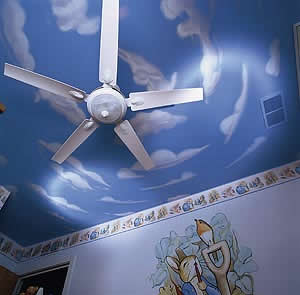
Hester Decorating Co.
With a full array of services and a strong preventative maintenance program, this company keeps its clientele happy.
by David Thompson
you hear the word “showroom”? Things like new cars, refrigerators or tuxedos might come to mind. But faux finishes? On display in a showroom?
It’s being done in Chicago.
Hester Decorating Company has two showrooms featuring four-by-eight-foot samples of its specialty finishes. One is in downtown Chicago, where visitors can browse more than 60 sample walls and 42 varieties of faux finished wood trim. The other is at the company’s home office in the Chicago suburb of Skokie, where some 70 wall samples are displayed.
A visit to one of the showrooms usually seals the deal with prospective clients who have sought estimates, says Jeff Hester, Hester Decorating’s suburban superintendent and estimator.
“The showrooms do wonderfully for us,” he says. “They let people actually see what Hester Decorating is.”
The company, a family-owned painting and specialty finish firm that concentrates on high-end, mostly residential work, was founded in 1968 by Tom Hester, who had a simple goal: “To be known as the best painting contractor around.” Tom started with three employees who worked out of the Hester family’s Skokie garage. Today the company employs about 40 union workers, including four paperhangers and nine faux finishers.
 Jeff Hester has worked in his father’s company since he was a kid, becoming a full-time employee in 1979. His brother Steve Hester is director of business operations, and another brother, now deceased, also worked for the company. The elder Hester and his wife, Marianne (who has done the company’s books from the beginning), have yet to retire, though they do migrate south each winter. Jeff Hester has worked in his father’s company since he was a kid, becoming a full-time employee in 1979. His brother Steve Hester is director of business operations, and another brother, now deceased, also worked for the company. The elder Hester and his wife, Marianne (who has done the company’s books from the beginning), have yet to retire, though they do migrate south each winter.
The company has painted, wallpapered, and applied faux and other finishes in numerous homes in Chicago’s toniest North Shore and Gold Coast neighborhoods. Its work can also be found in notable Windy City haunts such as Spiaggia restaurant, the Elizabeth Arden Salon Red Door Salon & Spa, and the ballroom at the Hyatt Regency Chicago.
“We’re definitely the Cadillac of the industry as far as quality,” Hester says. “When you’re paying close to $600 a day per man per house, you’re paying good money for a great job.”
Recently the company launched a commercial division, but residential work continues to account for most of its business.
Venetian plaster is among Hester’s hottest selling finishes. The company first used the finish on the walls of the Hyatt ballroom in the mid-1990s, before it had really caught on, Jeff Hester says.
“Back then Venetian plaster was probably $600 for a five gallon bucket — and a bucket didn’t go far,” Hester says. “Now there are so many different companies making it and different styles of Venetian plaster, that a bucket probably costs more like $150 to $200.”
Another popular finish is the linen look, created by cross-hatching a glazing liquid with steel wool. “It makes the walls literally look like linen,” Hester says.
For mudrooms, children’s play areas and other high-impact zones, a popular finish is created by applying a colored base coat and then a layer of gesso (the substance artists use to harden canvases), which is then textured with a trowel. “It’s really durable,” Hester says. “Practically indestructible.”
When it comes to brick, the company turns to staining.
Stains, unlike paint, don’t chip, and they allow brick’s natural characteristics to show through. The company’s craftsmen use up to six different color tones to create a graduated effect across the brickwork.
Much of their work involves staining brick fireplaces to match interior colors, but they also stain entire home exteriors.
“I just did a job on the exterior of a house that a guy had put a new slate roof on,” Hester says. “The slate made the brick look too orange, so we stained the whole exterior of the house to match. I had four guys there for five months — it was over a $100,000 job.”
|

